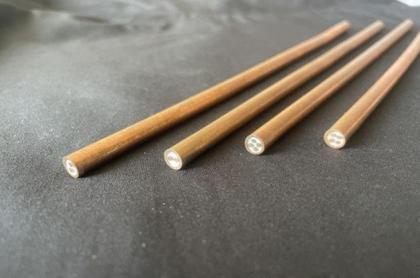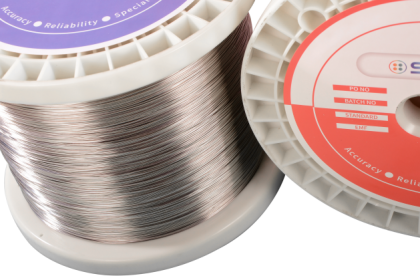Принцип измерения температуры термопары основан на термоэлектрическом эффекте, два разных проводника приварены на одном конце и подключаются на другом конце, чтобы сформировать закрытый петлей. Когда между этими двумя концами существует разность температур, цепь генерирует тепловую силу электроэлектродвигателя (также известную как силу теплового электроэлектрома). Феномен того, что термоэлектрический потенциал генерируется разницей температуры, называется «термоэлектрический эффект». Эти два разных проводника объединяются, чтобы сформировать термопару.
Согласно вышеуказанному принципу, необходимо выполнить следующие условия для термопары для генерации термоэлектрического потенциала: термопару должна состоять из двух материалов проводника с различными свойствами, но отвечающих определенным требованиям; Должна быть разница температур между рабочим концом термопары и контрольным концом. Чем больше разница температур между рабочим конце и опорным концом термопары, тем больше общий термоэлектрический потенциал. Материалы, необходимые для выбора двух разных проводников термопары, должны соответствовать следующим условиям: высокая физическая стабильность и химическая стабильность; Небольшой температурный коэффициент сопротивления и высокой проводимости; Сгенерированный термоэлектрический потенциал и температура должны находиться в линейной зависимости, воспроизводимость и производительность обработки является хорошей. После понимания основного принципа и структуры термопары он может обеспечить ярлык для устранения неполадок при ремонте термопары.
Во время визуального осмотра термопары в основном проверяются следующие аспекты: проверьте, находится ли коробка соединения в хорошем состоянии, независимо от того, согнута или сожжена защитная трубка; Аккуратно встряхните термопару и наблюдайте, есть ли в трубке какой -либо ненормальный звук. При разборке и осмотре проверьте, является ли терминал чистым или винты свободны; Вытащите тепловый электрод из защитной трубки и наблюдайте, является ли изолирующая труба влажная, независимо от того, имеет ли тепловый электрод поперечные трещины (нижняя термопару) или есть ли поверхность небольшие глубокие отметки, такие как разреза ножа (усовершенствованная термопару); Обратите внимание, является ли цвет термопарного соединения нормальным.
Отказ в использовании термопары, как правило, заключается в том, что выходной потенциал ниже или выше фактического значения, а термоэлектрический потенциал иногда отсутствует или нечувствителен.
1. Потенциал ниже фактического значения (индикация метра низкая)
(1) Ухудшаемый термопарный электрод или заплесневелый рабочий конец
Метод: отрежьте ухудшенную часть, повторно пройдите рабочий конец или замените новым электродом.
(2) Утечка влаги внутри термопары
Метод: выберите тепловый электрод, сухой и изолируйте фарфоровую трубку. Проверьте утечку защитной трубки. Те, кто терпит неудачу, должны отремонтировать сварку или заменить новую защитную трубку;
(3) Пыль между терминалами в соединительной коробке термопары или в железных заявлениях-короткометражные
Метод: используйте щетку для удаления пыли, удалите железные заявки и хорошо запечатайте соединительную коробку;
(4) Подключаемый винт в схеме измерения температуры термопары корродируется, а сопротивление цепи больше 15î ©
Метод: открутите ржавые винты и снимите ржавчину с помощью наждачной бумаги. Используйте мультиметр для проверки сопротивления петли, он должен соответствовать требованию 15î ©;
(5) Компенсационный провод влажного короткого замыкания
Метод: Снимите воду между компенсационным проводом и защитной трубкой, устраните точку короткого замыкания, замените новый компенсационный провод и принимайте водонепроницаемые и меры по профилактике короткого замыкания;
(6) Неправильная конфигурация типа компенсационной проволоки и типа термопары
Метод: замените компенсационный провод, сопоставляемый с термопарой;
(7) Полярность компенсационной проволоки и термопары перевернута.
Метод: воссоединить;
(8) Неправильное положение установки термопары, мелкая глубина вставки
Метод: выберите соответствующее место установки и отрегулируйте глубину вставки;
(9) Термопара не соответствует масштабам счетчика
Метод: заменить термопарой, которая соответствует шкале счетчика;
(10) Температура холодного соединения термопары слишком высока
Метод: переместите компенсационный провод для холодного соединения термопары в место, где температура ниже и относительно постоянной или точно исправляет температуру холодного соединения.
2. Потенциал иэрайнее, чем фактическое значение (индикация метра ихай)
(1) Термопара не соответствует масштабам счетчика
Метод: замените термопару на счетчик метра;
(2) Термопара не соответствует компенсационной проволоке
Метод: замените компенсационный провод на тот, который соответствует термопару;
(3) Неправильная установка термопары
Метод: выберите подходящее место установки;
(4) Термопара или компенсационный провод, заземленной последовательно с дополнительным потенциалом заземления
Метод: проверьте точку заземления и исправьте ее.
3. Термический потенциал является спорадическим (индикация метра колеблется)
(1) Винт, закрепляющий термод на терминале термопары, свободен
Метод: затяните винты на терминалах;
(2) Прерывистые короткие замыкания, заземления, отключения или свободные установки в цепи измерения термопары
Метод: Проверьте термопару и компенсационную проволоку, исключите точку заземления и сварьте компенсационный провод и тепловой электрод и затяните фиксирующие винты.
(3) Термопара качается из -за свободной установки
Метод: твердо установите термопару.
4. Термопара нечувствительна к изменениям теплового потенциала
(1) Ухудшенные термопарные электроды
Метод: вырезать короткую и повторно пройти или заменить электрод;
(2) Неправильная установка термопары
Метод: изменить место установки;
(3) Пыль на внешней коже термопары защиты
Метод: Снимите термопару и снимите пыль из оболочки.
5. Внимание
(1) В соответствии с темой и объектом измерения выберите соответствующую термопару и защитную оболочку, компенсатор холодного соединения, компенсационный провод и вторичный инструмент. Выпускные номера должны быть последовательными;
<00(2) Место установки термопары должно избегать быть близкими к горячим объектам, таким как двери печи и места с сильными магнитными полями. Перекрестная коробка термопары не должна контактировать с измеренным средним контейнером или стенкой трубы. Температура холодного соединения, как правило, не должна превышать 100 ° C. Не устанавливайте выводы термопары в том же проводнике, что и кабели питания;
(3) Глубина вставки термопары, как правило, требует, чтобы рабочий конец был установлен как можно больше за пределами центра трубы примерно на 5-10 мм, а рабочий конец и жидкость, которая должна быть измерена, должны быть перпендикулярными или обратными 45 ° Полем Если это требование не может быть выполнено и требуется горизонтальная установка, для поддержки следует использовать кронштейн из рефрактерной глины или термостойкого металла. Выходное отверстие в соединительной коробке должно быть вниз, чтобы предотвратить въезд влаги, пыли и грязи из -за плохого герметизации;
(4) Глубина вставки термопары должна быть не менее 8-10 раз больше диаметра самой защитной трубки. В противном случае должна быть добавлена трубка расширения;
(5) Когда термопару установлена на сосуде под давлением, его производительность герметизации должна быть строго гарантирована, а защитная оболочка с фарфором должна избежать внезапного тепла и внезапного охлаждения, чтобы предотвратить разрыв фарфоровой трубки. Установка должна находиться в месте, которое не мешает удалению или установке другого оборудования;
(6) При измерении температуры поверхности трубопровода поверхность должна быть чистой, горячий конец должен быть в хорошем контакте с поверхностью, установка должна быть хорошо изолирована, компенсационный провод и проволоку должны быть защищены, а также Полярность должна обращать внимание на проводку;
(7) Термопара должна регулярно проверять и может использоваться после прохождения теста.






 Specated Ipv6 Network
Specated Ipv6 Network